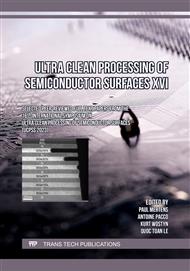p.275
p.280
p.289
p.296
p.302
p.311
p.318
p.325
p.331
Eco-Friendly SPM Alternative Resist Stripping with High-Concentration O3-Water Technology
Abstract:
A large amount of chemicals and ultrapure water (UPW) have been used for wet cleaning process in the semiconductor manufacturing processes. One of the most commonly used cleaning solutions is Sulfuric acid (H2SO4) and Hydrogen Peroxide (H2O2) Mixture (SPM). It is used for resist stripping, etc. on a silicon wafer. As the cleaning process increases, so does the amount of chemicals used with the recent miniaturization. As a result, wastewater will also increase, and there are concerns about the impact on the environmental aspects. The technologies to reduce H2SO4 [1, 2] have been developed, but its consumption still persists. Therefore, in this paper, we developed high concentrated O3-water without using H2SO4, and conducted a resist stripping test verify its effectiveness as an alternative to SPM.
Info:
Periodical:
Pages:
302-307
Citation:
Online since:
August 2023
Price:
Сopyright:
© 2023 Trans Tech Publications Ltd. All Rights Reserved
Share:
Citation:


